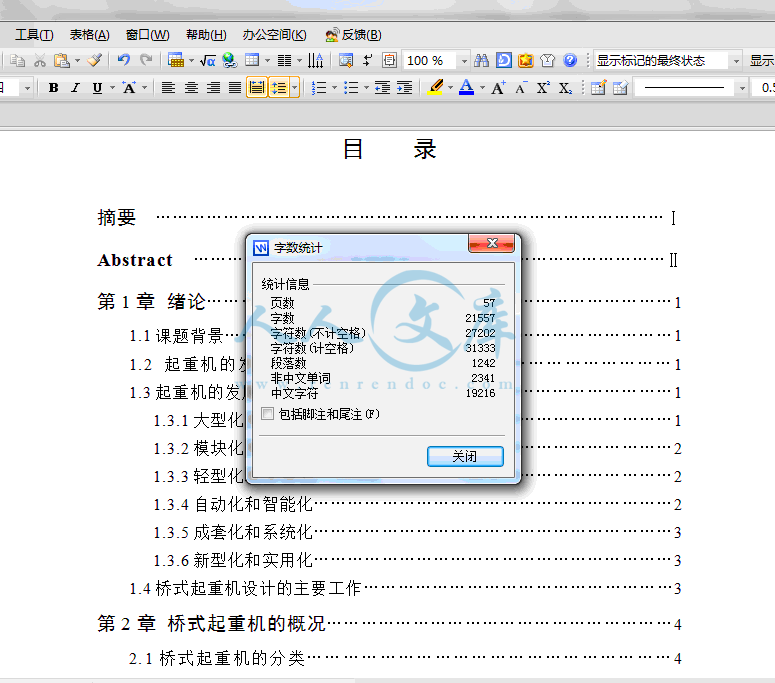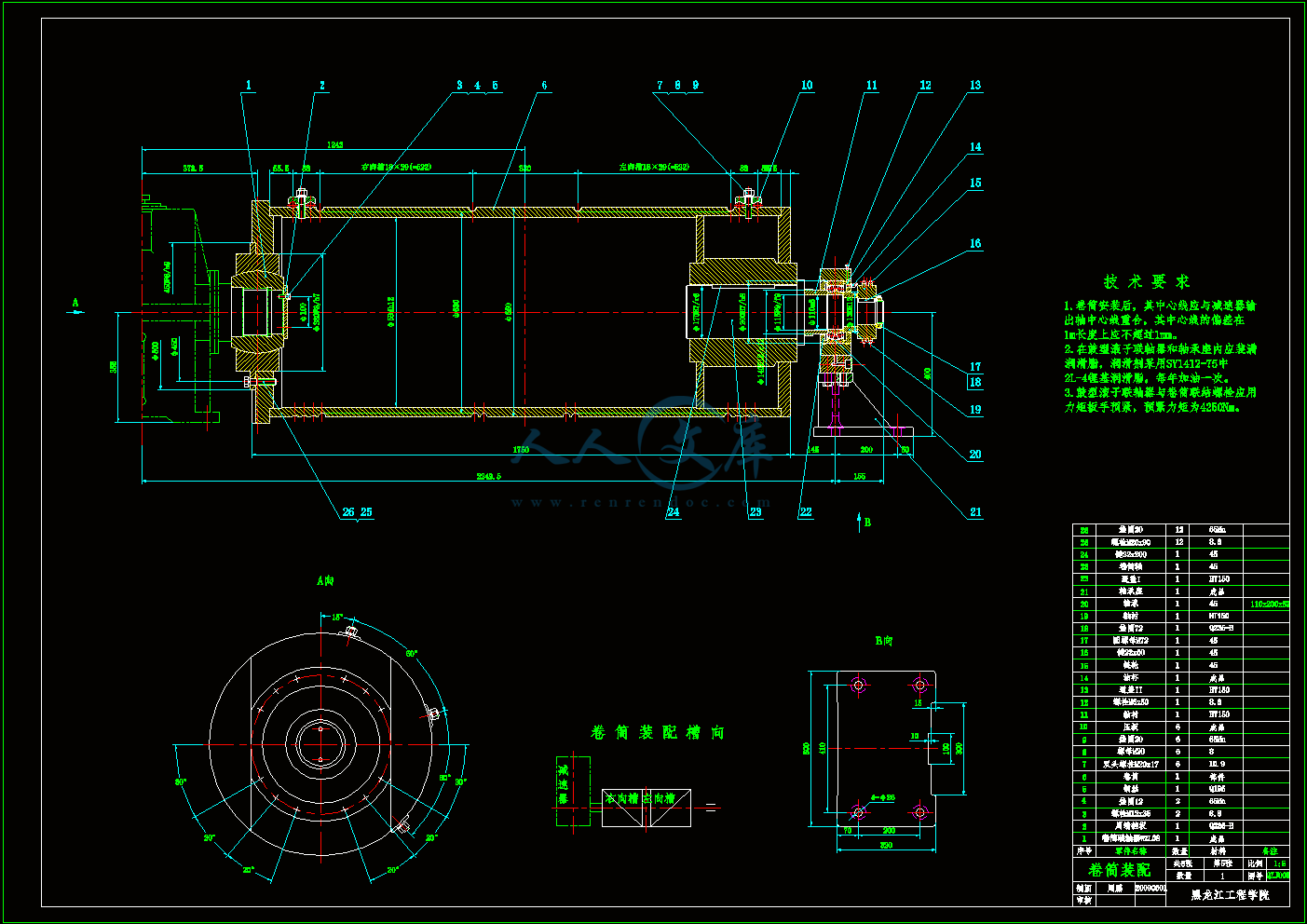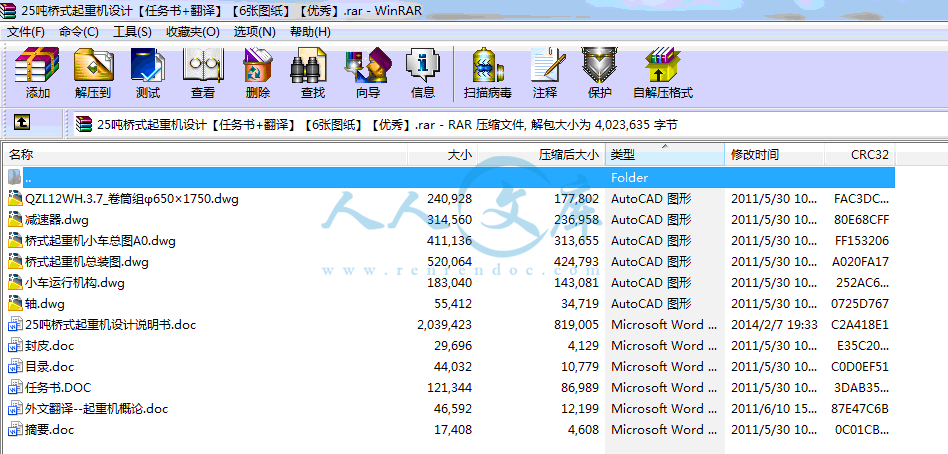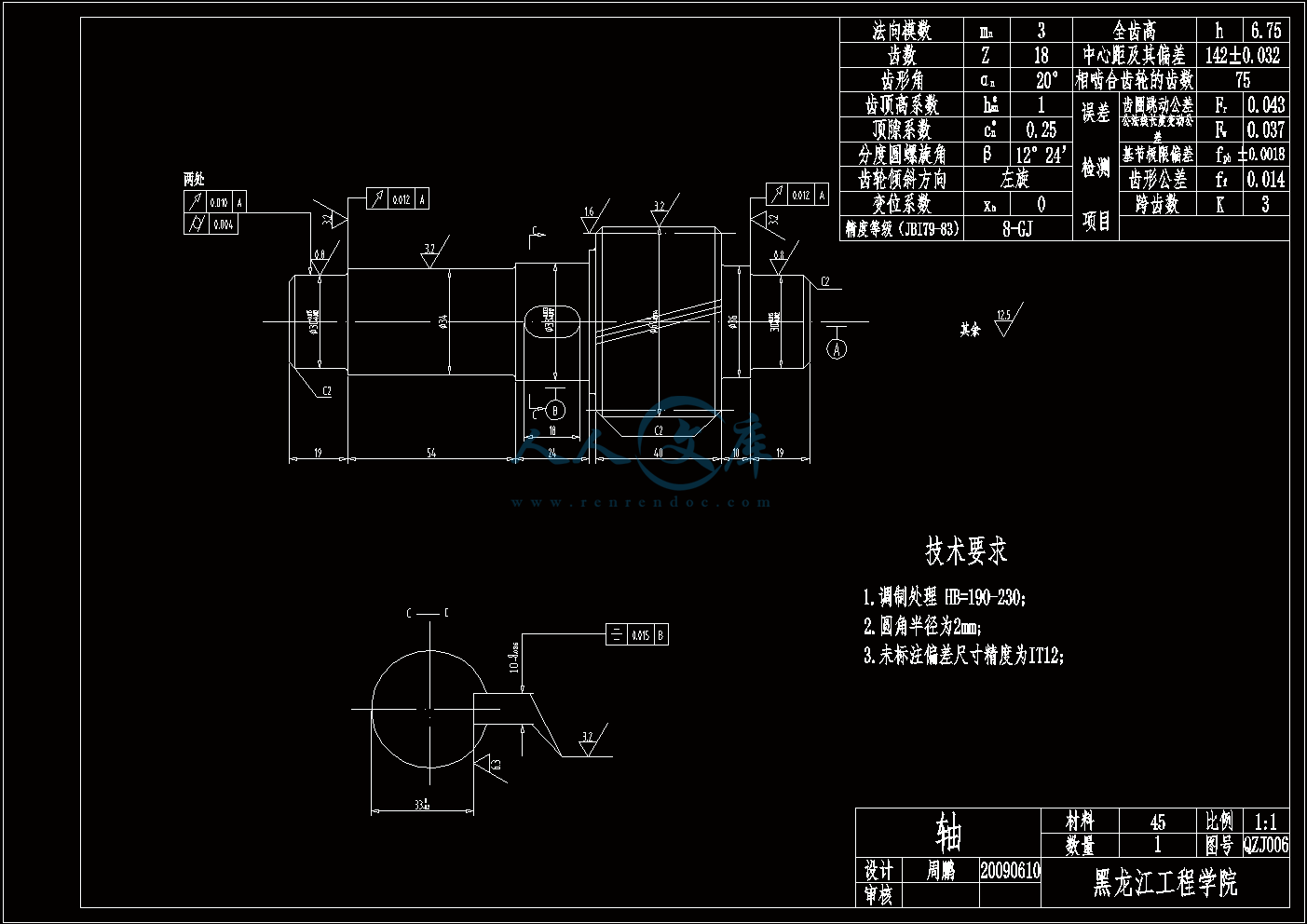25吨桥式起重机设计
57页 21000字数+说明书+任务书+外文翻译+6张CAD图纸【详情如下】
QZL12WH.3.7_卷筒组φ650×1750.dwg
任务书.DOC
减速器.dwg
外文翻译--起重机概论.doc
封皮.doc
小车运行机构.dwg
摘要.doc
桥式起重机小车总图A0.dwg
桥式起重机总装图.dwg
目录.doc
轴.dwg
25吨桥式起重机设计说明书.doc








目录
摘要 ………………………………………………………………………………Ⅰ
Abstract …………………………………………………………………………Ⅱ
第1章 绪论………………………………………………………………………1
1.1课题背景……………………………………………………………………1
1.2 起重机的发展历史……………………………………………………1
1.3起重机的发展的发展趋势…………………………………………………1
1.3.1大型化和专用化………………………………………………………1
1.3.2模块化和组合化………………………………………………………2
1.3.3轻型化和多样化………………………………………………………2
1.3.4自动化和智能化………………………………………………………2
1.3.5成套化和系统化………………………………………………………3
1.3.6新型化和实用化………………………………………………………3
1.4桥式起重机设计的主要工作………………………………………………3
第2章 桥式起重机的概况……………………………………………………4
2.1桥式起重机的分类……………………………………………………4
2.1.1通用桥式起重机………………………………………………………4
2.1.2专用桥式起重机………………………………………………………5
2.1.3电动葫芦型桥式起重机………………………………………………5
2.2 桥式起重机的组成和特点…………………………………………………6
2.2.1桥式起重小车………………………………………………………6
2.2.2桥式起重小车运行机构……………………………………………9
2.2.3起升机构……………………………………………………………9
2.2.4起重机运行机构……………………………………………………9
2.2.5桥架的金属结构……………………………………………………10
2.3 本章小结…………………………………………………………………10
第3章 运行小车的设计…………………………………………………11
3.1运行机构的计算…………………………………………………………11
3.1.1 运行阻力计算………………………………………………………11
3.1.2 电动机的选择………………………………………………………12
3.1.3 制动器的选择………………………………………………………15
3.1.4 联轴器的选择………………………………………………………16
3.1.5运行打滑验算………………………………………………………16
3.2 本章小结……………………………………………………………17
第4章 减速器的设计…………………………………………………………18
4.1计算传动装置的运动和动力参数…………………………………………18
4.1.1减速器传动比的分配……………………………………………… 18
4.1.2减速器各轴的动力参数…………………………………………… 18
4.2 齿轮的设计计算…………………………………………………………19
4.2.1高速级齿轮的计算………………………………………………… 19
4.2.2中速级齿轮的计算………………………………………………… 22
4.2.3低速级齿轮的计算………………………………………………… 25
4.3 轴的设计…………………………………………………………………29
4.3.1轴Ⅱ的设计计算……………………………………………………29
4.3.2轴Ⅰ的设计计算……………………………………………………34
4.3.3轴Ⅲ的设计计算……………………………………………………36
4.3.4轴Ⅳ的设计计算……………………………………………………37
4.4滚动轴承的选择与计算……………………………………………………38
4.5 联轴器的选择……………………………………………………………40
4.6键的选择与校核 …………………………………………………………40
4.7润滑与密封 ………………………………………………………………41
4.8减速器的设计资料 ………………………………………………………41
4.9本章小结 …………………………………………………………………42
第5章主梁的设计计算…………………………………………………………43
5.1作用于主梁上的载荷………………………………………………………………43
5.2计算载荷及其组合…………………………………………………………43
5.3 主梁的强度计算…………………………………………………………………43
5.4 主梁的刚度计算…………………………………………………………46
5.5 本章小结…………………………………………………………………47
结论………………………………………………………………………………48
参考文献………………………………………………………………………49
致谢…………………………………………………………………………………50
附录………………………………………………………………………………51
摘 要
起重机的出现大大提高了人们的劳动效率,以前需要许多人花长时间才能搬动的大型物件现在用起重机就能轻易达到效果,尤其是在小范围的搬动过程中起重机的作用是相当明显的。在工厂的厂房内搬运大型零件或重型装置桥式起重机是不可获缺的。
桥式起重机小车主要包括起升机构、小车架、小车运行机构、吊具等部分。其中的小车运行机构主要由减速器、主动轮组、从动轮组、传动轴和一些连接件组成。
此次设计的桥式起重机是水电站桥式起重机,安装于丰满水电站扩建工程厂房内,用于水轮发电机组及其附属设备的安装和检修工作。水电站内设备一般都是大中型设备,对桥式起重机的载荷要求较高,所以对减速器性能要求较高。
关键词:桥式起重机;小车架;小车运行机构;吊具;减速器
桥式起重机的分类2.1.1 通用桥式起重机 通用桥式起重机是指在一般环境中工作的普通用途的桥式起重机。以下类型的起重机都属于通用桥式起重机。???? 1、通用吊钩桥式起重机
通用吊钩桥式起重机由金属结构、大车运行机构、小车运行机构、起升机构、电器及控制系统及司机室组成。取物装置为吊钩。额定起重量为10t以下的多为1个起升机构;16t以上的则多为主、副两个起升机构。这类起重机能在大多数作业环境中装卸和搬运物料及设备。??? ?2、电磁桥式起重机???? 电磁桥式起重机的基本构造与吊钩桥式起重机相同,不同的是吊钩上挂1个直流起重电磁铁,用来吊运具有导磁性的黑色金属及其制品。通常是经过设在桥架走台上电动发电机组或装在司机室内的可控硅直流箱将交流电源变为直流电源,然后再通过设在小车架上的专用电缆卷筒,将直流电源用挠性电缆送到起重电磁铁上。
3、抓斗桥式起重机???? 抓斗桥式起重机的装置为抓斗,以钢丝绳分别连接抓斗起升、起升机构、开闭机构。主要用于散货、废旧钢铁、木材等的装卸、吊运作业。这种起重机除了起升闭合机构以外,其结构部件等与通用吊钩桥式起重机相同。??? ?4、两用桥式起重机???? 两用桥式起重机有3种类型:抓斗吊钩桥式起重机、电磁吊钩桥式起重机和抓斗电磁桥式起重机。其特点是在1台小车上设有两套各处独立的起升机构,一套为抓斗用,一套为吊钩用(或一套为电磁吸盘用一套为吊钩用,或一套为抓斗用一套为电磁吸盘用)。???? 5、三用桥式起重机???? 三用桥式起重机是一种多用的起重机。其基本构造与电磁桥式起重机相同。根据需要可以用吊钩吊运重物,也可以在吊钩上挂1个马达抓斗装卸物料,还可以把抓斗卸下来再挂上电磁盘吊运黑色金属,故称为三用桥式起重机。???? 6、双小车桥式起重机???? 这种起重机与吊钩桥式起重机基本相同,只是在桥架上装有2台起重量相同的小车。这种机型用于吊运与装卸长形物件。2.1.2 专用桥式起重机???? 1、冶金桥式起重机??? 冶金桥式起重机根据用途可以划分为不同的类型,主要结构基本与通用吊钩桥式起重机相同,取物装置多为专用。主要用于冶金车间的吊运作业,其起重量很大,最大的可达到数百吨。??? 2、绝缘吊钩桥式起重机 这种起重机结构形式与通用吊钩桥式起重机基本相同。但是为了防止工作过程中带电设备的电流可经过被吊物传到起重机上,危及司机安全,故要求在吊钩组、小车架、小车轮上设置3道绝缘装置。主要用于冶炼铝、镁的工厂。
3、防爆吊钩桥式起重机???? 这种起重机的结构形式与通用吊钩桥式起重机基本相同。但是所用的整套电气设置具有防爆性能。与钢轨接触的运行车轮要采用不易产生摩擦火花的材料制作,以防止在起重机使用中产生火花引起爆炸或燃烧事故。主要用于具有易燃易爆物的车间、库房或其他场所。目前产品规格较多。
2.1.3 电动葫芦型桥式起重机???? 其特点是桥式起重机的起重小车用自行式电动葫芦代替,或者用固定式电动葫芦作起重小车的起升机构,小车运行、大车运行等机构的传动装置也尽量与电动葫芦部件通用化。因此,与上述通用桥式起重机相比,电动葫芦型桥式起重机虽然一般起重量较小、工作速度较慢、工作级别较低,但其自重轻、能耗较小、易采用标准产品电动葫芦配套,而且对厂房等建筑物的压力较小,建筑和使用经济性都较好。
1、电动梁式起重机???? 其特点是用自行式电动葫芦替代通用桥式起重机的起重小车,用电动葫芦的运行小车在单根主梁的工字钢下突缘上运行,跨度小时直接用工字钢作主梁,跨度大时可在主梁工字钢的上面再作水平加强,形成的组合断面主梁。其主梁可以是单根主梁,也可以是两根主梁,其桥架可以是像通用桥式起重机那样通过运行装置直接支撑在高架轨道上,也可以通过运行装置悬挂在房顶下面的架空轨道上。
 川公网安备: 51019002004831号
川公网安备: 51019002004831号